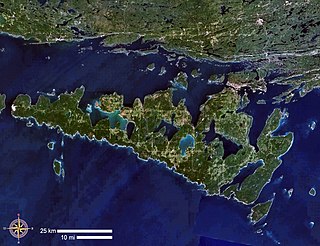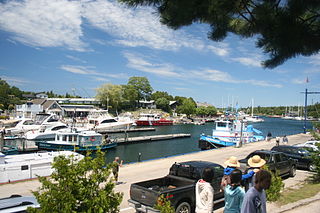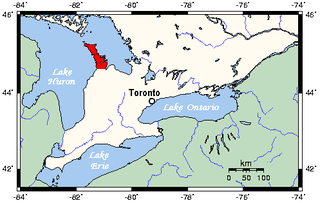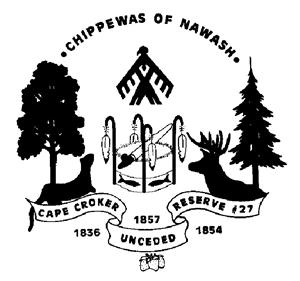Related Research Articles

Manitoulin Island is an island in Lake Huron, located within the borders of the Canadian province of Ontario, in the bioregion known as Laurentia. With an area of 2,766 km2 (1,068 sq mi), it is the largest lake island in the world, large enough that it has over 100 lakes itself. In addition to the historic Anishinaabe and European settlement of the island, archaeological discoveries at Sheguiandah have demonstrated Paleo-Indian and Archaic cultures dating from 10,000 BC to 2,000 BC.

The Ojibwe are an Anishinaabe people whose homeland covers much of the Great Lakes region and the northern plains, extending into the subarctic and throughout the northeastern woodlands. Ojibweg, being Indigenous peoples of the Northeastern Woodlands and of the subarctic, are known by several names, including Ojibway or Chippewa. As a large ethnic group, several distinct nations also understand themselves to be Ojibwe as well, including the Saulteaux, Nipissings, and Oji-Cree.

Tobermory is a small community located at the northern tip of the Bruce Peninsula, in the traditional territory of the Saugeen Ojibway Nation. Until European colonization in the mid-19th century, the Bruce Peninsula was home to the Saugeen Ojibway nations, with their earliest ancestors reaching the area as early as 7,500 years ago. It is part of the municipality of Northern Bruce Peninsula. It is 300 kilometres northwest of Toronto. The closest city to Tobermory is Owen Sound, 100 kilometres south of Tobermory and connected by Highway 6.

Bruce County is a county in Southwestern Ontario, Canada. It has eight lower-tier municipalities with a total 2016 population of 66,491. It is named for James Bruce, 8th Earl of Elgin and 12th Earl of Kincardine, the sixth Governor General of the Province of Canada. The Bruce name is also linked to the Bruce Trail and the Bruce Peninsula.

The Odawa are an Indigenous American people who primarily inhabit land in the Eastern Woodlands region, now in jurisdictions of the northeastern United States and southeastern Canada. Their territory long preceded the creation of the current border between the two countries in the 18th and 19th centuries.

The Bruce Peninsula is a peninsula in Ontario, Canada, that divides Georgian Bay of Lake Huron from the lake's main basin. The peninsula extends roughly northwestwards from the rest of Southwestern Ontario, pointing towards Manitoulin Island, with which it forms the widest strait joining Georgian Bay to the rest of Lake Huron. The Bruce Peninsula contains part of the geological formation known as the Niagara Escarpment. The entire peninsula and nearby communities to the south along Lake Huron are located within Bruce County, Ontario.
Saugeen First Nation is an Ojibway First Nation band located along the Saugeen River and Bruce Peninsula in Ontario, Canada. The band states that their legal name is the "Chippewas of Saugeen". Organized in the mid-1970s, Saugeen First Nation is the primary "political successor apparent" to the Chippewas of Saugeen Ojibway Territory; the other First Nation that is a part of Chippewas of Saugeen Ojibway Territory is Cape Croker. The Ojibway are of the Algonquian languages family. The First Nation consist of four reserves: Chief's Point 28, Saugeen 29, Saugeen Hunting Grounds 60A, and Saugeen and Cape Croker Fishing Islands 1.

The Grand Traverse Band of Ottawa and Chippewa Indians is a federally recognized Native American tribe located in northwest Michigan on the Leelanau Peninsula. Sam McClellan is the current tribal chairman, elected in June 2016 to a four-year term after succeeding Al Pedwaydon, who served from 2012 to 2016.
Nahnebahwequa or Catherine Bunch was an Ojibwa spokeswoman and Christian Missionary.

The Wiikwemkoong First Nation is a First Nation on Manitoulin Island in Northern Ontario. The Wiikwemkoong Unceded Territory is the First Nation reserve in the northeast of Manitoulin Island in Manitoulin District, Ontario, Canada. Wiikwemkoong is an unceded Indigenous reserve in Canada, which means that it has not "relinquished title to its land to the government by treaty or otherwise."

Ottawa or Odawa is a dialect of the Ojibwe language spoken by the Odawa people in southern Ontario in Canada, and northern Michigan in the United States. Descendants of migrant Ottawa speakers live in Kansas and Oklahoma. The first recorded meeting of Ottawa speakers and Europeans occurred in 1615 when a party of Ottawas encountered explorer Samuel de Champlain on the north shore of Georgian Bay. Ottawa is written in an alphabetic system using Latin letters, and is known to its speakers as Nishnaabemwin 'speaking the native language' or Daawaamwin 'speaking Ottawa'.
The Robinson Treaties are two treaties signed between the Ojibwa chiefs and the Crown in 1850 in the Province of Canada. The first treaty involved Ojibwa chiefs along the north shore of Lake Superior, and is known as the Robinson Superior Treaty. The second treaty, signed two days later, included Ojibwa chiefs from along the eastern and northern shores of Lake Huron, and is known as the Robinson Huron Treaty. The Wiikwemkoong First Nation did not sign either treaty, and their land is considered "unceded".
The Saugeen Ojibway Nation Territory, also known as Saugeen Ojibway Nation, SON and the Chippewas of Saugeen Ojibway Territory, is the name applied to Chippewas of Nawash Unceded First Nation and Saugeen First Nation as a collective, represented by a joint council. The collective First Nations are Ojibway (Anishinaabe) peoples located on the eastern shores of Lake Huron on the Bruce Peninsula in Ontario, Canada. Though predominantly Ojibway, due to large influx of refugees from the south and west after the War of 1812, the descendants of the Chippewas of Saugeen Ojibway Territory also have ancestry traced to Odawa and Potawatomi peoples.

Chippewas of Nawash Unceded First Nation is an Anishinaabek First Nation from the Bruce Peninsula region in Ontario, Canada. Along with the Saugeen First Nation, they form the Saugeen Ojibway Nation. The Chippewas of Nawash Unceded First Nation had a registered membership of 2758 individuals, as of December 2020. Approximately 700 members live on the main reserve, Neyaashiinigmiing 27. The First Nation has 3 reserves, Neyaashiinigmiing 27, Cape Croker Hunting Ground 60B and Saugeen and Cape Croker Fishing Islands 1. The size of all reserves is 8083.70 hectares.
Charles Rankin, was an early Irish-born and Scottish-descended settler and land surveyor in Upper Canada. He is significant due to his role in the surveying and early settlement of large areas of Upper Canada, including much of the Bruce Peninsula and south shore of Lake Huron, and notably the city of Owen Sound. Born in 1797 at Enniskillen, County Fermanagh, Ireland, he died in either 1886 or 1888 in Owen Sound, a city whose founding he had been instrumental in.
The Ojibway Nation of Saugeen is an Ojibwa First Nation in the Canadian province of Ontario. The Nation is located in the Thunder Bay District, approximately 20 kilometres northwest of Savant Lake. In December, 2007, its total registered population was 206, of which the on-reserve population was 72. The community maintains strong ties with Mishkeegogamang First Nation
Saugeen may refer to the following in Ontario, Canada:

The Saugeen complex was a First Nations culture located around the southeast shores of Lake Huron and the Bruce Peninsula, around the London area, and possibly as far east as the Grand River. They were active in the period 200 BCE to 500 CE. Archeological evidence suggests that Saugeen complex people of the Bruce Peninsula may have evolved into the Odawa people (Ottawa).
Saugeen and Cape Croker Fishing Islands 1 is a First Nations reserve consisting of 89 islands in Lake Huron off the western coast of the Bruce Peninsula in Ontario. They extend north of Chief's Point 28 for 11 miles (18 km) up to Pike Bay. These islands are shared between the Chippewas of Nawash Unceded First Nation and Saugeen First Nation.
Treaty 45, referred to variously as the Manitoulin Island treaty, the treaty of Manitowaning, or the Bond Head treaty, is a treaty that, by its terms, converted the whole of Manitoulin Island, then in Upper Canada, into a reserve.
References
- "Map of the Area of the 9 August 1836 Treaty (Saugeen)". atlas.gc.ca. 2003. Archived from the original on February 15, 2012.
- Surtees, R. (1986). "The Making Of The Manitoulin Treaty, 1836". Manitoulin Island Treaties. Indian and Northern Affairs Canada.
{{cite book}}:|website=ignored (help) - "45½". Indian treaties and surrenders, from 1680 to 1890. Vol. I. Ottawa: King's Printer. 1905. p. 113.